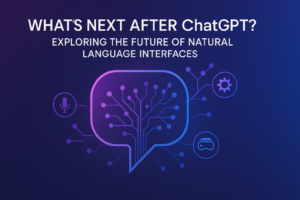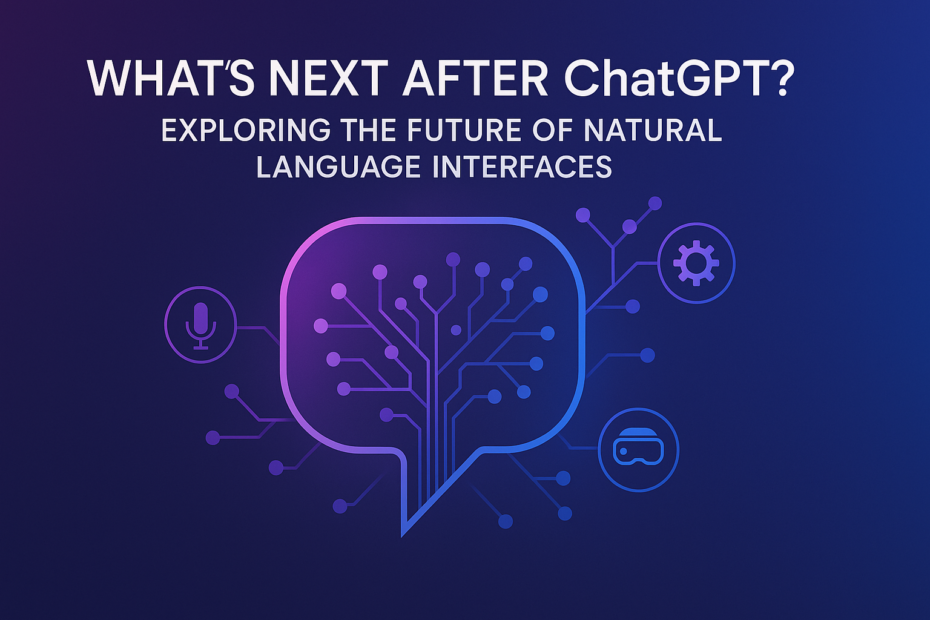
A few years ago, talking to your computer was a novelty. Today, it’s a norm. Thanks to advancements in large language models like ChatGPT, people are now using natural language to write code, summarize meetings, draft legal documents, and even get dating advice. But as mind-blowing as these interactions may seem, they’re only the beginning.
We’re standing on the edge of a major evolution—one that will redefine how we interact with technology entirely. So, what comes after ChatGPT? What will natural language interfaces (NLIs) look like in the next 5 to 10 years? This article explores the emerging trends, technologies, and philosophical shifts that could shape our post-ChatGPT world.
From Prompt to Partner: The Rise of Agentic AI
ChatGPT and its cousins are great at responding to prompts. You ask something, they respond. But what happens when the assistant doesn’t just respond—but acts?
Enter agentic AI: a class of models that don’t just generate text, but can take autonomous actions, interact with software, browse the web, make decisions, and complete goals. Tools like AutoGPT and Devin (the AI software engineer) are early examples of this concept.
Imagine asking your assistant to “Book me a vacation to Bali for under $1,500, sometime in September, and make sure it’s pet-friendly.” Instead of giving you a list, your assistant books the flight, reserves the hotel, checks the pet policies, and adds the dates to your calendar—without needing you to click a thing.
This is where we’re headed: toward agents that behave like full digital employees rather than just chat companions.
Contextual Intelligence: Memory, Emotion, and Personalization
Right now, ChatGPT remembers a few things about you in a single session, and even then, its memory can be fragile. But future NLIs will build persistent, evolving user models.
Think of it as having a personal AI that grows with you—learning your tone, values, goals, preferences, and communication style. It remembers that you hate early morning meetings, love puns, and prefer your emails short and polite.
This deeper contextual intelligence will make conversations feel more human, more intuitive, and more emotionally intelligent. Your assistant won’t just complete tasks—it’ll understand you.
But this brings up an important question: how much should AI know about us?
The Trust Paradox: Privacy and Ownership in Natural Interfaces
As NLIs get smarter, they need more data. The trade-off is clear: better performance in exchange for deeper insight into our lives.
That’s where trust becomes a bottleneck. If your assistant remembers every detail of your digital footprint, from past Google searches to conversations with your therapist, where does privacy end and convenience begin?
Companies will have to walk a tightrope between personalization and data protection. There’s already a push for local AI (on-device language models), encrypted memory, and user-controlled data logs. In the future, your AI assistant may live entirely on your phone or home server, trained only on your data, and invisible to any cloud provider.
Natural language interfaces won’t just be judged on intelligence—they’ll be judged on ethics.
The End of the App Era?
Natural language interfaces aren’t just making software easier—they’re challenging the very idea of interfaces.
We’ve spent the last two decades building software around buttons, sliders, dashboards, and checkboxes. But what happens when you can say, “Sort my emails, prioritize anything from my boss or clients, and schedule replies for tomorrow morning”?
The GUI (graphical user interface) may give way to the CUI—conversational user interface. Apps will become “skills” your assistant uses behind the scenes. You won’t need to open Spotify to queue a playlist or launch Excel to generate a report. You’ll just ask.
Developers will shift from building front-ends to building functions, plug-ins, and agents. The focus will move from UX design to conversational design.
It’s not the end of apps—but it could be the end of the visible app era.
Multimodality: Moving Beyond Text and Speech
Natural language doesn’t just mean words. Humans communicate using tone, gesture, facial expression, images, and even silence.
The future of NLIs will combine text, voice, video, images, haptics, and maybe even brain signals. We’re already seeing progress here:
- GPT-4V (Vision) can interpret images and graphs alongside text.
- Meta and Google are experimenting with voice-first AIs that can carry on unscripted conversations.
- Neuralink (and other startups) are exploring brain-computer interfaces that could one day let you think commands instead of saying them.
Imagine an AI assistant that watches your Zoom call, reads body language cues, senses fatigue in your voice, and quietly suggests, “Want me to cancel your next meeting so you can take a break?”
When communication becomes truly multi-modal, interfaces will feel not just smart, but empathetic.
The Enterprise Transformation
Natural language interfaces won’t just change how individuals interact with tech—they’ll change how entire businesses operate.
Instead of clunky CRMs and endless Excel macros, imagine a team dashboard where you just say:
“Pull up last quarter’s sales reports, highlight anything that dropped by more than 15%, and draft an action plan for each.”
Or you tell your internal AI:
“Organize next week’s product launch, coordinate with marketing and supply chain, and alert me if anything’s at risk.”
In this future, every employee gets their own virtual assistant. Work becomes less about software and more about intent. The bottleneck shifts from technical skill to strategic clarity.
The org chart might change too. AI agents will manage tasks, synthesize information, and even report to human managers. The question then becomes: what kind of manager will you be—to your human and AI teammates alike?
Creativity, Consciousness, and the Philosophical Frontier
As these systems get more lifelike, we start facing weirder questions:
- Can you fall in love with an AI?
- If it remembers your life better than you do, is it a “digital soulmate”?
- Should AI assistants have moral limits?
- Who’s responsible if an agent makes a bad decision on your behalf?
The boundary between tool and companion is starting to blur. Some people already treat chatbots as therapists, coaches, or friends. As memory, emotional nuance, and real-world integration improve, the line may disappear altogether.
We’ll need new frameworks—not just technical ones, but philosophical and legal ones. We might need “AI rights” or at least “AI responsibilities.”
Because once your assistant has a personality, memory, and role in your life—it’s not just software anymore.
Final Thoughts: The Interface is Becoming Invisible
In the 80s, the future of computing was the mouse and keyboard. In the 2000s, it was the touchscreen. In the 2020s, it’s the prompt.
But in the 2030s, we might not need an interface at all.
The most powerful technologies disappear into the background. Electricity. The internet. GPS. Soon, language itself may become the universal interface—no clicks, no swipes, no screens. Just talking, listening, understanding.
We’re not just building smarter software. We’re building something new: a way to live alongside intelligence.
So, what comes after ChatGPT?
A world where talking to machines feels as natural as talking to people. And sometimes, even better.
